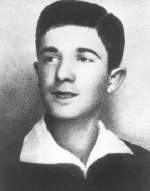Mordechai Anielewicz was born in Warsaw in
1919,
to a poor family. After finishing secondary school, he soon joined the Zionist movement
Ha-Shomer
ha- Tsa’ir, where he distinguished himself as an organiser and leader. In
early 1940 he was working full time for the underground, establishing youth
groups and underground newspapers. By
mid-1941, Anielewicz
began concentrating on transforming the underground youth movements into an armed resistance movement.
He also began creating self-defence organisations in the
Warsaw Ghetto.
Anielewicz was not in the Warsaw Ghetto during the
summer of 1942
when the mass deportations of Warsaw Jewry to
Treblinka took place. Upon his return to the ghetto only
60,000 of the former 350,000 Jewish inhabitants of Warsaw remained. Anielewicz was determined
to reinvigorate the Jewish Combat Organisation – the
Zydowska Organizacja Bojowa (ZOB)
- and actively fight back, firstly against those Jews who had helped the Germans during the Great
Deportation, such as
Jacob Lejkin and
Jozef Szerynski
from the Jewish
Ordnungsdienst and "Israel First", and secondly against the Nazis.
Following the end of the mass deportations from Warsaw in
September 1942,
there was far more support in the ghetto than ever before for resisting further deportations, and in
building shelters in which to hide. Most existing underground groups joined the ZOB. Anielewicz was
appointed commander of the ZOB in
November 1942,
and in the following months a small quantity of arms was obtained from the Polish underground.
On
18 January 1943,
Ferdinand von Sammern-Frankenegg
(
SSPF Warschau) - organised the second phase of mass deportations, following
Heinrich Himmler’s orders to remove excess Jews from the ghetto.
Caught by surprise, the ZOB staff did not have time to co-ordinate a unified resistance, but Anielewicz
and other key ZOB members, such as
Eliyahu Rozanski and
Margalit Landau joined a group of deportees destined for the
Umschlagplatz.
The fighters dispersed along the length of this march, and each of its members singled out one of the
soldiers guarding the line. At a given signal, the fighters sprang out of line and opened fire. A short
fight, at the corner of
Zamenhofa and
Niska, followed,
with a number of Germans killed and wounded, while others fled. It is therefore understandable that no
account of the fight or the casualties can be found in any German source. Most of the Jewish fighters fell
as well.
Eliyahu Rozanski, who had assassinated
Lejkin, fought with great valour in this incident, was seriously wounded and
subsequently died of his wounds.
Margalit Landau, who was
also involved in that assassination, likewise fell in this battle. Anielewicz himself fought until his ammunition
ran out, then snatched a gun out of the hands of a German soldier and was saved by the intervention
of another quick-witted fighter.
Tuvia Borzykowski,
who witnessed this episode, recorded:
“
...Though the unit was destroyed, the battle on
Niska Street encouraged us. For the first time since the occupation
we saw Germans clinging to walls, crawling on the ground, running for cover, hesitating before
making a step in the fear of being hit by a Jewish bullet...”
German forces continued to search the ghetto in the following days, until quite suddenly they
withdrew. At the time, the Jews only possessed 10 pistols. Had the Germans known this, the raids
would probably have continued and the resistance would have been nipped in the bud. Instead it
grew in strength and determination, so that on
19 April 1943,
when German soldiers once again entered the ghetto, they were met by much greater armed Jewish
resistance. The
Warsaw Ghetto Uprising had begun.
On
23 April, Anielewicz wrote to
Yitzhak Zuckerman, who was seeking help for the uprising on the "Aryan" side. The letter concluded:
"
Keep well. Perhaps we’ll see each other. What’s most important;
the dream of my life has become a reality. I lived to see Jewish defence in the ghetto in
all its greatness and splendour."
As the fighting in the ghetto continued, Anielewicz and the senior ZOB figurers retreated to the
ZOB Central Bunker at
18 Mila Street.
On
8 May 1943, the bunker was discovered, its five exits were blocked,
the main entrance was broken open, and canisters of poisonous gas were thrown inside. Some of the
ZOB members committed suicide some fell in the battle. How Mordechai Anielwicz died is not known.
But his heroism and that of his companions roused
Hirsh Glik in the
Vilnius Ghetto to write a song in Yiddish that was to become a
symbol of defiance and of hope, as well as a source of inspiration, for Jews everywhere:
Zog Nit Keynmol (Never Say)
The melody of this song can be heard at
http://fcit.usf.edu/holocaust/arts/muspart.htm
SOURCES:
Gilbert, Martin.
The Holocaust – The Jewish Tragedy, William Collins Sons & Co. Limited, London, 1986
Gutman, Yisrael.
The Jews of Warsaw 1939- 1943, The Harvester Press Ltd, Brighton, 1982
http://www.csjo.org/pages/holidays/pesach.htm
© ARC (http://www.deathcamps.org) 2006








